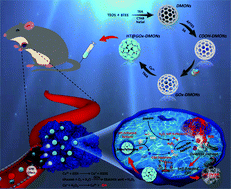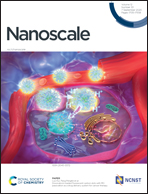A pH-activated autocatalytic nanoreactor for self-boosting Fenton-like chemodynamic therapy†
Abstract
The emergence of hydroxyl radical (˙OH)-mediated chemodynamic therapy (CDT) by the Fenton or Fenton-like reaction holds great potential for improving anticancer efficacy. Herein, an activatable autocatalytic nanoreactor (HT@GOx-DMONs) was developed for self-boosting Fenton-like CDT via decorating Cu2+-based metal-organic frameworks (MOFs) on glucose oxidase (GOx)-loaded dendritic mesoporous organosilica nanoparticles (DMONs) for the first time. The obtained nanoreactor could prevent the premature leakage of Cu2+ and GOx in neutral physiological environments conducted by the gatekeeper of growing carboxylate MOF (HKUST-1), but the explosive release of agents was realized due to the activated degradation of external HKUST-1 in acidic condition of endo/lysosomes, which thereby endowed this nanoreactor with the performance of pH-triggered ˙OH generation driven by Cu+-mediated autocatalytic Fenton-like reaction. Excitingly, Cu2+-induced glutathione (GSH) depletion and GOx-catalyzed H2O2 self-sufficiency unlocked by acid dramatically enhanced ˙OH generation. As expected, the effect of self-amplified CDT based on Cu2+-containing HT@GOx-DMONs presented wonderful in vitro toxicity and in vivo antitumor ability without leading to significant side-effects. The resulting nanoreactor with GSH consumption and H2O2 self-supply activated by acid may provide a promising paradigm for on-demand CDT.



 Please wait while we load your content...
Please wait while we load your content...